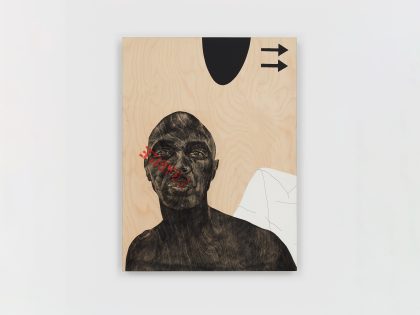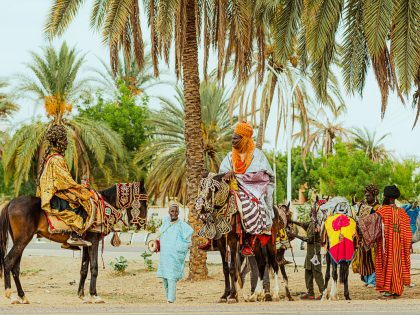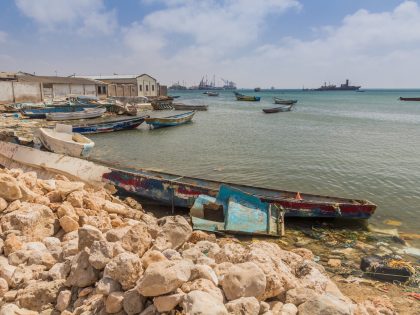The Prisoner and his Pin-up Girl
Apartheid's prisons tolerated 'National Geographic; For Nelson Mandela, who knew better, it was porn.

The National Geographic issue of July 1975 is as delightful a time capsule as you would expect from the magazine that dictated our understanding of the world. On the very first page is an advertisement for Iran Air—against a backdrop of the Manhattan skyline. “Now fly to New York five times a week,” the copy cheerfully proclaims, four years before a revolution and a hostage crisis resulted in the US government tossing the airline out of its airspace. There’s plenty of the usual stuff—bleak Malthusian stories on the hunger games of that decade, and despatches from Cape Cod, the Ozarks, and Philadelphia. In the middle of them all, bookended by ads for a Datsun sports car and the Beechcraft Baron—“You don’t have to live near the water to live near the water”—is a gem of a feature on living near the water, “The Last Andaman Islanders”, written and photographed by the late Raghubir Singh.
Singh documents the Jarawas, or what was left of them, with élan. These “brutish idolaters” who, in Marco Polo’s account, “killed and ate every outsider they could lay their hands on,” treated him quite sweetly. He realised their famous hostility was simply a survival strategy. His crew was plied with drink, taken on a memorable hunt for “wild screaming pigs,” and fondled by muscular tribesmen. The words in the feature are fine, but it is the photographs that leap off the page. One photograph in particular: a Jarawa woman, dancing in an “explosion of merriment” that accompanied the crew’s arrival on shore, according to the caption—which curmudgeonly goes on to add that some Jarawas still distrust strangers and will therefore attack and kill them.
This volcanic little piece of joy, of course, ended up in a prison cell thousands of miles west—in another penal colony, on another remote island, designed by another European occupier. The Dutch turned Robben Island into a holding facility in the 1600s; the English brought civilization to the Andaman and Nicobar islands by setting up a prison there in the 1700s. For the apartheid-era correctional system, National Geographic was presumably a gesture of cultural benevolence; to Nelson Mandela, who knew better, it was porn. He named her Nolitha.
My dearest Winnie, Your beautiful photo still stands about two feet above my left shoulder as I write this note. I dust it carefully every morning, for to do so gives me the pleasant feeling that I’m caressing you as in the old days. I even touch your nose with mine to recapture the electric current that used to flush through my blood whenever I did so. Nolitha stands on the table directly opposite me. How can my spirits ever be down when I enjoy the fond attentions of such wonderful ladies?
You don’t have to be serving time to see her appeal. There she is, unabashed, naked, dancing on the seashore, radiant in the sun, every bit of her throbbing with sexual energy.
Prison did not diminish Mandela’s keen interest in the body. When his daughter Zindzi expressed hesitation at attending her sister Zenani’s wedding—Zenani was marrying a Swazi prince, and Zindzi was worried she would have to go bare-breasted to the ceremony—Mandela wrote her a charming note of encouragement.
The beauty of a woman lies as much in her face as in her body. Your breasts should be as hard as apples and as dangerous as cannon balls. You can proudly and honourably display them when occasion demands.
In fact, the prisoner and his pin-up girl had more in common than they might have been aware of. Both of them were thorns in the side of their states. Despite Jawaharlal Nehru’s public exhortations on behalf of India’s tribal people—“…a people who sing and dance and try to enjoy life; not people who sit in stock exchanges, shout at each other, and think themselves civilised”—his state blundered into their lives and continues to confound them to this day. Both of them were endlessly romanticized, though they would have probably preferred to do a little romanticizing themselves (we know at least one of the two found that opportunity in the pages of a magazine). More significantly, regardless of their different physical predicaments— and this is what made them inexplicable to authority—both of them knew they were free.
***
I learnt of Nolitha on Mandela’s 86th birthday in Johannesburg. The year was 2004, Thabo Mbeki’s second term as president of South Africa had just commenced, and the struggle veteran Mac Maharaj had been left out in the cold. He shrewdly used his time to remind the grand old man of his lost love (Maharaj has since been rehabilitated, and currently serves as President Jacob Zuma’s spokesperson). The Sunday Times carried a picture: a beaming Mandela, holding a framed copy of the photograph, with his archivist Verne Harris and assistant Zelda la Grange standing by. This is what I heard. Mandela received the present at a public function, and toyed with Maharaj by insinuating his pipe was likely to be stocked with something stronger than tobacco. Some time later, after Harris unwrapped the present and discovered what it was, he took it straight to his employer, who was thrilled to be reunited with the image (the original photograph had been discarded with other detritus of his prison cell, years ago). Mandela considered Nolitha wistfully, and voiced a heartfelt concern. Women these days, he felt, wore far too many clothes. He looked up at his staff for affirmation, and they collapsed with laughter.
In Celebrity, an unremarkable Woody Allen film, a character played by Charlize Theron and identified only as the “supermodel” has a remarkable problem. The problem, by way of Sigmund Freud and Allen’s enduring obsession with psychoanalysis, is that she is polymorphously perverse. “It’s not a flaw, it’s just a weakness,” she offers, tentatively. “Every part of my body gives me sexual pleasure.” The character who hears her confession is Lee Simon, a failed middle-aged writer played by Kenneth Branagh, who is broken enough to appreciate what he has found. After he strokes her hand into near-orgasm, Simon feverishly thanks the Lord. “…And that was just her hand!”
I can’t say I’ve ever encountered this problem—watching Silk Smitha unfurl in Sadma might be the closest I’ll ever get —but I think I recognize the broad sentiment. I’m old enough to know it’s a blessing, a retrospective reward for a childhood spent futilely banging on the windows of the world to be let in. And I will admit to being unreasonably excited by Mandela’s choice of stimulation on Robben Island; it sounded like the left-handed reading habits of my import-substituted middle-class youth. When things are scarce, the whole world becomes perversely polymorphous. Every third-world child of a certain vintage knows this. When pleasure is out of reach, it’s waiting in plain sight to be discovered; it’s in Margaret Mead’s Coming of Age in Samoa, it’s in Masters & Johnson, it is, somewhat oddly, in the Thai Ramayana, and it is absolutely and definitely in the pages of the National Geographic, a publication that has thoughtfully featured naked women in my skin tone all the way since 1896.
You could dismiss my pulchritude and call it names; exploitation, or tourism, or, worse, anthropology. I suppose you could even call it poverty porn. A cute put-down, sure, but spare a thought for those of us who didn’t have the luxury of consuming enough porn to casually throw it away as a metaphor (and a negative one at that). It’s like brother Oscar said: A cynic is a man who knows the price of everything and the value of nothing.
While it is widely acknowledged that Mandela left the details of the presidency to his deputy, Mbeki, it isn’t impossible to imagine that some part of the cosmic force he brought to the ambassadorial role he assumed—the indefatigable smile, the fragile political handling, the constant travel, the fund-raising, the pitch-perfect symbolism of his every action, the scrupulous care given to all his millions of social interactions—came from having nowhere to go and not much to do for decades on end.
Mandela was acutely aware of the redeeming value of scarcity, and carried it all the way into his wealthy sunset. He said as much when asked how he kept himself fit. On Robben Island, he explained, he ate brown bread, porridge and lean meat, and was consigned to hard labour. A punishment—for paler prisoners got whiter bread, fatter meat and softer work; and yet, also deliverance—for the enforced restraint preserved his perfect frame all the way to the end.
***
I know we’re supposed to be grateful to Mandela keeping South Africa “stable”—which, in the language of racial double-speak roughly translates to “Thanks for not messing with the nice white overclass who messed with you all your life.” But however standard the revenge-as-reconciliation model might be in our neighbourhood and other broken parts of the world, it is still a ridiculously low standard to apply to any human being in any part of the world. (Is there any one else on earth who will ever be thanked so much for what he didn’t do?) And it’s hardly like Mandela solved all of South Africa’s problems. Survey after survey shows in the period after 1994, of all the races that make the country, white people and Indians saw the biggest rises in their income, while black people and so-called “coloureds”—a collective 90% of the population—did not benefit anywhere nearly as much. Plenty of activists in South Africa think he didn’t go far enough with land redistribution, especially in comparison to Zimbabwe’s Robert Mugabe; they chafe at the “St. Mandela/Mad Bob” formulation that sets land reform up as something only a deranged dictator would do.
On the other side of the fence, the Wall Street Journal put forth a theory suggesting he is loved because he had the foresight to become what the American nation in general, meaning the Wall Street Journal editorial board in particular, wanted: an enthusiastic capitalist who saw the light and “transcended his party’s history of Marxism, tribalism and violence.”
The cold-warriors responsible for this last assessment received a splendid smackdown from the race-warrior Rev. Al Sharpton. “I think it is a betrayal of history to act as if…as Nelson Mandela evolved, the world embraced him,” he said on the American network MSNBC. “Let’s remember, the ANC, they were pursuing freedom,” he continued. “Many of the Communist nations embraced them, this country did not. It was not like they were born Marxist; they were born people seeking to be free… We chose sides. We chose the wrong side.”
Sharpton was echoing a point Mandela himself had made in an unusually heated interview with American television anchor Ted Koppel during his first visit to the US, shortly after his release from prison in 1990. Chided for his support of Yasser Arafat’s PLO and Fidel Castro’s Cuba, Mandela stood his ground, defending the ANC’s right to be loyal to old friends, reminding Koppel of the many Jewish people who were integral to the liberation struggle in South Africa.
This much is true: Mandela bent the world to fall at his feet. He wasn’t interested in turning into the person we wanted him to be; he trained us to embrace him for who he was. He had a striking fashion sense and recognized the irresistibility of his image early on. He put this power to good use in 1962, after his arrest, when he wore the traditional outfit of a Xhosa chief to his arraignment, an animal-skin cloak draped over one shoulder, the other bare, his body crowned by a bead necklace. He continued the tradition in sharp suits through the 1990s—he really rocked those suits—and with flamboyant floral shirts that became his trademark. He was funny and warm and a wicked flirt, and neither made any effort to hide these feelings, nor bothered to disguise all the other pesky human traits that made him vivid and real. In prison, he was “fixated” with Pantene hair oil, his fellow Robben Island inmate, Ahmed Kathrada told the New York Times. During one prolonged period of unavailability—dubbed “The Pantene Crisis”—he enlisted every influential visitor who came his way into this struggle.
“When Mandela dies,” the Johannesburg-based political theorist Achille Mbembe wrote in a stirring piece for Le Monde diplomatique this August, “we will be entitled to declare the 20th century is over.” Mbembe was referring to the wave of anti-colonial and racial justice movements that swept the last century, which themselves emerged out of the churn of abolitionist movements in the 19th century, a long and dramatic continuum of which Mandela was our last significant link. If the future is now open, let’s place on record just how unusual a third-world hero he was. In an arena where tropical leaders—the good ones at least—are seemingly required by law to be dour revolutionaries or dull technocrats, all of them carefully scrubbed of any trace of humanity, here was a man who was interested in fashion, sex, and humour, a man who had no trouble being fierce and dignified while wearing his heart on his sleeve. For the better part of a century, Mandela spun humanity right round, and now, it seems only fair that the world stop spinning for him.
A version of this piece first appeared in Mint Lounge on December 21.



















